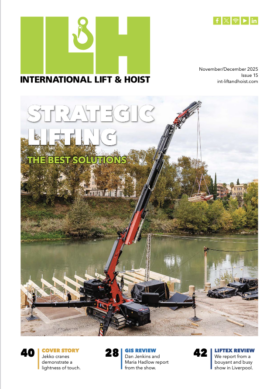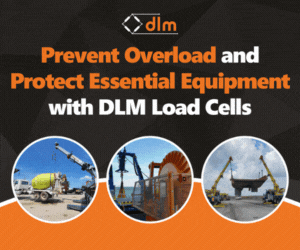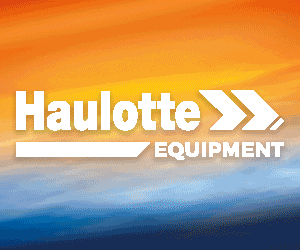)
Industry’s Lift Plan
As we raise the profile of our industry, we must continue to elevate safety standards, says Joel Cox.
Last year I gave the inaugural Global Lifting Awareness Day my full support and, once again, I will join my colleagues and wider industry in raising the profile of the crane, hoist and rigging sector when #GLAD2021 (that’s the event hashtag on social media) takes place on 8 July. I applaud the UK-headquartered Lifting Equipment Engineers Association (LEEA) for driving the programme and recognise that this magazine is also a stakeholder in this endeavour.
In planning our contributions to the event, from talking about how we found ourselves in the industry, to celebrating the ubiquity of lifting equipment in the real world, I took a step back to look at the sector as though from a perspective as though I was an outsider. After all, an integral part of the #GLAD2021 concept is promotion of our marketplace to young people. Across the world, we’re dealing with an ageing workforce and we are clearly not succeeding in making the lifting equipment market attractive enough to convince engineers, marketers, financiers, etc. to start their careers with us. This really is the battle because history tells us that once people enter the industry, they stay in the industry.
There are a number of barometers that young people use by which to measure the appeal of an industry. In terms of longevity, earning potential, technology, people, travel opportunities, etc we check off a lot of these boxes. It’s true though that younger generations have spent their lives in a more safety conscious world, certainly more than those approaching retirement age.
It’s important therefore that, as we promote our industry, we continue to raise safety standards. Imagine the damage it can do, and how quickly programmes like #GLAD2021, can lose momentum, when crane and hoist accident stories and photos go viral. On a weekly basis we see crane incidents or near-misses on video that could easily have been avoided had a lift plan been in place.
It makes our industry look dangerous and dated—a lethal cocktail, indeed.
Safety symposium
Safety was inevitably at the forefront of my mind as I sat down (socially distanced) with Mike Astemborski, executive sales manager here at Pintsch Bubenzer USA, to plan our opening-day presentation at the upcoming Association for Iron & Steel Technology (AIST) Crane Symposium, which takes place 15-17 August at the Omni William Penn Hotel in Pittsburgh, Pennsylvania. The fact that there remains a need for a paper titled, ‘Lifting or lowering a load safely after failure or incident’ suggests that there is still room for improvement, even in a current super-safe industry like steel.
There is a safety centricity to the whole event. In fact, the symposium, organised by AIST’s Cranes Technology Committee, sets out to deliver practical information and experiences from maintenance personnel, crane manufacturers, equipment manufacturers and engineering consultants with the sole intention of making electric overhead travelling (EOT) cranes and their runways the safest, most reliable, durable machines in the industry.
Of course, despite the content of our presentation, we want to prevent failure or incident before it happens. Many accidents occur because of an oversight at the planning stages, or the lack of a sufficient lift plan. I don’t want to confuse people, especially newcomers to the industry, by trying to differentiate between critical lifts, critical lift planning and lift planning. For the purposes of this article, it’s important to have a plan, particularly when heavy, large, awkwardly-shaped, valuable or hazardous loads are being lifted.
As a manufacturer of high performance disc and drum brakes for steel cranes and other severe duty applications, there is generally a possibility of catastrophe involved in our daily challenges. I have been part of hundreds of critical lifts, most commonly with large tonnage overhead cranes. Between water bag load tests, nuclear reactor lifts, lifting complete cranes, to install and refurbishment, the applications are varied. We are often also involved in lift plans on testing our brakes on large scale equipment or completing load tests for verification process.
It is a misperception that a load has to be heavy to require a lift plan, however. It might be that the critical element is continued operation or there is another risk to eradicate. It’s also a myth that lift planning is more relevant to outdoor, tower crane lifts. In fact, these lifts are very often more routine than those that take place out of sight. Many critical lifts are actually part of an engineered plan to lift above the original scope of design, or use cranes in tandem inside a factory. An example might be a rotor or turbine that would need to be lifted or turned using two cranes, where the load represents millions of dollars of investment.
Hot topic
In what we call ‘hot’ reactor or radioactive lift plans, integral to the plan would be limiting human exposure. Here in the US, the Occupational Safety and Health Administration (OSHA) most commonly refers to lift planning when people are involved in or around the load. OSHA also cites 1910.179(n), which is worth researching.
The US Army Corps of Engineers, meanwhile, defines a critical lift as any non-routine crane lift requiring detailed planning and additional or unusual safety precautions. It adds that critical lifts include lifts made where the load weight is greater than 75% of the rated capacity of the crane; lifts which require load to be lifted, swung or placed out of the operator’s view; lifts made with more than one crane; lifts involving a non-routine/technically difficult rigging arrangement; hoisting personnel with a crane or derrick; or any lift that the crane operator believes should be critical.
Of course, an inadequate plan is as bad as no plan at all. I’ve long been campaigning for lift plans to be beefed up further, to include more “what if” scenarios. For example, what happens if there is a broken shaft during a critical lift, or failed motor windings, or a gearbox failure? These type of questions or thoughts of prevention can lead to better maintenance, proper sizing and fine-tuned critical lift plans. In all instances, a lift plan should include emergency numbers, details of rigging gear, clarification of blind spots, special considerations and controls – as a minimum (see insert).
That’s not to say there is a perfect lift plan and no two lift plans are the same. Loads and wear and tear on cranes create many variables to consider along with different personal. A lift plan cannot be a copy and paste exercise, although if someone is frequently planning lifts they will certainly get a feel for the key components.
We should use previous lift plans more readily for continuous improvement. Also, a plan is a useful document should something go wrong. I have been on many accident investigations in my career and the plan, or lack of one, is a good starting point for the investigation team. Armed with a document, details of inspection and pre-use checklists, a clear picture of how an incident happened begins to emerge.
Lift plan checklist
Before making a critical lift, a plan, prepared by a qualified person, such as the crane operator, supervisor, or rigger, should be considered. The lift plan should be documented in writing and made available to all personnel involved in the lift. Usually a paper copy will suffice but, increasingly, they are produced digitally. Regardless, a critical lift plan should include the following information as a minimum:
Description of the lift
Crane position and configuration
Lift height
Load radius
Boom length and angle
Size and weight of the load
Percent of crane’s rated capacity
Personnel involved
Rigging plan
Communication method
Ground conditions
Environmental conditions
Inspection procedures
Procedures for hoisting personnel (if applicable)











